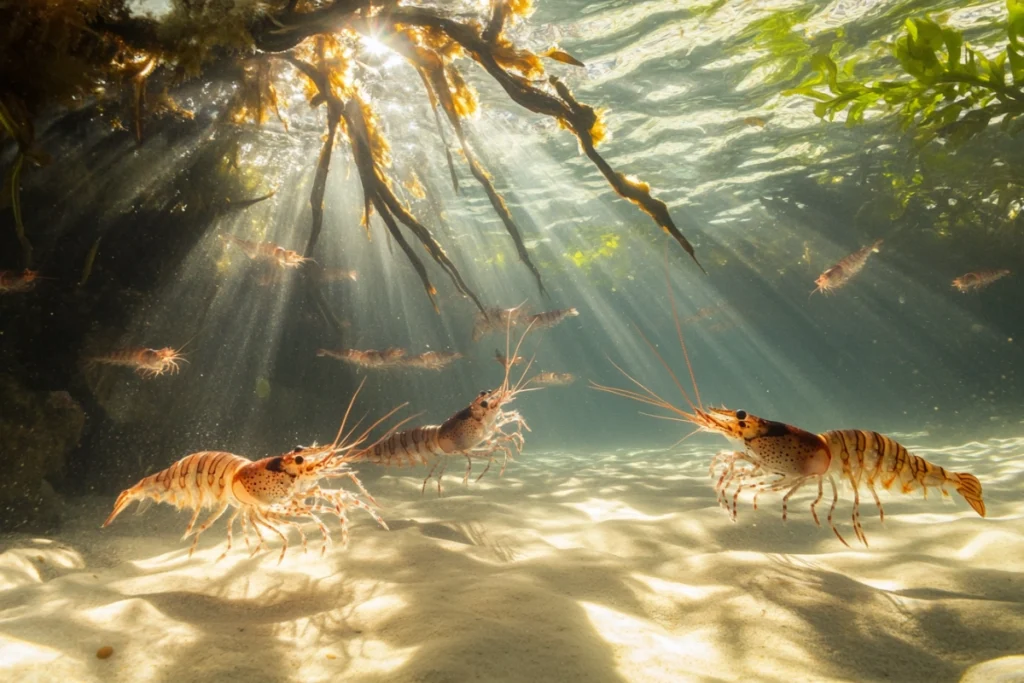Tiger shrimp, also known as black tiger prawns, are a fascinating marine species celebrated for their unique biological traits, ecological significance, and culinary appeal. Found in tropical and subtropical waters, these creatures play a vital role in marine ecosystems and global seafood markets. However, their growing popularity has sparked both opportunities and challenges, especially concerning sustainability and environmental conservation.
In this article, we’ll dive into the remarkable features of tiger shrimp, their lifecycle, economic importance, and the pressing need for sustainable practices. Let’s explore what sets them apart from other shrimp species.
Overview of Tiger Shrimp
Introduction to Tiger Shrimp
The striped shrimp, scientifically known as Penaeus monodon, are among the largest and most sought-after shrimp species worldwide. Recognized for their striking striped exoskeleton, they thrive in warm, coastal waters and are often found in estuaries and mangroves. Their adaptability to various habitats, from brackish water to deep-sea environments, contributes to their widespread presence.
These shrimp are known for their rapid growth and prolific reproduction. Females can lay hundreds of thousands of eggs in a single cycle, ensuring the species’ survival in both natural and farmed environments. The combination of their unique appearance, fast growth, and high demand makes tiger shrimp a preferred choice in aquaculture and fisheries.
Life Cycle and Behavior
The striped shrimp have a fascinating lifecycle, beginning as planktonic larvae in open oceans. These larvae gradually transition to juveniles, finding shelter in estuaries where they grow and molt. As they mature, The striped shrimp migrate to soft-bottom coastal waters, their preferred adult habitat.
Their molting process is particularly intriguing. Since their exoskeletons cannot expand, tiger shrimp must periodically shed their shells to grow. During this time, they are vulnerable to predators, as their new exoskeleton remains soft for hours after molting.
Behaviorally, tiger shrimp are omnivorous scavengers. They feed on a diverse diet of algae, detritus, and small invertebrates, playing a vital role in maintaining the health of marine ecosystems. This dietary flexibility allows them to thrive in varied environments, making them resilient but also impactful as an invasive species in certain regions.

This introduction to tiger shrimp lays the groundwork for understanding their biological and ecological importance. In the next part, we’ll uncover the unique biological features that make tiger shrimp so special. Stay tuned!
Unique Biological Features of Tiger Shrimp
Molting Process
One of the most fascinating traits of tiger shrimp is their molting process. Unlike mammals, shrimp possess a hard exoskeleton that doesn’t grow as they do. To accommodate their growth, they must shed this outer shell in a process known as molting. Before molting begins, a new, larger exoskeleton forms beneath the current one. When the old shell splits, the shrimp emerges, revealing its soft and vulnerable new layer. It takes a few hours for this new exoskeleton to harden completely, leaving the shrimp susceptible to predators during this critical time.
This cyclical process not only facilitates their growth but also plays a crucial role in their survival. The ability to rebuild and strengthen their shells allows tiger shrimp to adapt to their dynamic marine environment.
Omnivorous Diet
The striped shrimp have an incredibly versatile diet, which contributes to their adaptability in diverse habitats. These shrimp are omnivorous, feeding on algal material, detritus, other invertebrates, and even decaying organic matter. This diverse menu sustains them in both wild ecosystems and aquaculture settings.
Their diet also impacts their role in marine ecosystems. By consuming decaying matter and algae, tiger shrimp contribute to nutrient cycling, keeping their habitats balanced. However, their omnivorous habits make them a potential threat in non-native areas, where they may outcompete local species. This adaptability is part of what makes them so unique and significant in the aquatic world.
Economic Importance of Tiger Shrimp
Fisheries and Market Demand
The global demand for tiger shrimp is enormous, making them a cornerstone of the seafood industry. Known for their large size, sweet flavor, and appealing texture, these shrimp are a staple in cuisines worldwide. Their commercial value has fueled large-scale fishing and farming operations, particularly in countries across Asia and Latin America.
Unfortunately, traditional fishing methods like bottom trawling used to harvest tiger shrimp can harm marine ecosystems. These methods often result in high bycatch rates, capturing unintended species like turtles and small fish. Efforts to introduce more sustainable techniques, such as using traps, are growing but require broader adoption to make a significant impact.
Aquaculture Practices
Aquaculture has become a key method for meeting the ever-increasing demand for tiger shrimp. Farming these shrimp allows for controlled breeding, ensuring a steady supply. However, this practice isn’t without its challenges. Large-scale shrimp farms can damage coastal ecosystems, particularly mangrove forests, which are often cleared for ponds.
Additionally, the accidental release of farmed tiger shrimp into the wild can lead to invasive populations, threatening local marine life. Water pollution from shrimp farms is another concern, as untreated waste disrupts nearby habitats.
Despite these challenges, advancements in sustainable aquaculture aim to minimize environmental harm. Innovations like closed-loop systems and biofloc technology are promising steps toward a greener future for tiger shrimp farming.
For a guide on preparing tiger shrimp dishes that align with sustainable choices, you might explore this tiger shrimp guide on Medium Recipes.
Environmental Concerns and Sustainability
Impact of Fishing Techniques
The fishing methods used to harvest tiger shrimp often take a toll on marine ecosystems. One of the most widely used techniques, bottom trawling, involves dragging heavy nets across the seafloor. This method is efficient but destructive, damaging delicate habitats and contributing to high levels of bycatch. Species like sea turtles, small fish, and even other invertebrates frequently become unintended victims.
This environmental impact has led to calls for more sustainable practices. Alternatives such as prawn traps offer a less invasive way to catch tiger shrimp. While traps reduce bycatch and minimize harm to the seafloor, they are less economically viable for large-scale operations. Efforts to refine and promote these methods are ongoing, but widespread adoption remains a challenge.
Challenges with Aquaculture
While aquaculture has helped reduce fishing pressure on wild populations, it has created its own environmental issues. Many tiger shrimp farms are built by clearing coastal ecosystems like mangrove forests, which serve as critical habitats for marine life. This destruction not only displaces wildlife but also exposes coastal areas to erosion and storm damage.
Another concern is pollution. Shrimp farms often release untreated waste into nearby waters, disrupting local ecosystems. The use of antibiotics and chemicals to manage shrimp health further complicates the environmental footprint of aquaculture. Despite these challenges, advancements in sustainable shrimp farming, such as integrated multi-trophic aquaculture (IMTA) systems, show promise for reducing these impacts.
For ideas on incorporating The striped shrimp sustainably into your diet, check out this tiger shrimp recipe guide on Medium Recipes.
Conservation Efforts for Tiger Shrimp
Sustainable Practices in Fisheries
To address the environmental challenges associated with tiger shrimp, many organizations and governments are working to promote sustainable fishing practices. Policies encouraging the use of eco-friendly gear, such as prawn traps, aim to reduce the harmful effects of traditional trawling methods. Additionally, certifications like the Marine Stewardship Council (MSC) label help consumers identify seafood sourced sustainably.
Education is another key component. By raising awareness about the ecological impact of unsustainable shrimp harvesting, conservation groups are empowering consumers to make informed choices. Opting for shrimp labeled as sustainably sourced can create demand for more responsible fishing practices.
Role of Regulations and Education
Stronger regulations are crucial to protecting tiger shrimp and their habitats. In many regions, laws now restrict where and how shrimp farms can operate to minimize ecological harm. Enforcement of these rules ensures that coastal ecosystems, such as mangroves, are preserved.
Educational campaigns also play a vital role. By teaching communities about the importance of preserving tiger shrimp habitats, these initiatives foster a sense of stewardship. Youth-focused programs, such as those by environmental groups, inspire future generations to prioritize conservation efforts.
For more information about tiger shrimp and other sustainable seafood options, explore more articles on Medium Recipes. Their comprehensive guides provide insights into sustainable sourcing and preparation techniques.
Parts 4 and 5 address the environmental challenges and conservation efforts tied to tiger shrimp, offering a comprehensive look at what makes them so special. In the next section, we’ll explore their cultural and culinary significance!
Cultural and Culinary Significance

Culinary Appeal
The striped shrimp have long been celebrated for their exquisite taste and versatility in the kitchen. Their firm texture and slightly sweet flavor make them a favorite ingredient in a variety of cuisines. From Asian stir-fries and spicy curries to Mediterranean grills and seafood platters, tiger shrimp can adapt to a multitude of flavors and cooking techniques.
One of the features that make The striped shrimp stand out is their impressive size, which allows them to hold up well in dishes that require grilling or frying. Whether sautéed with garlic and butter or marinated in exotic spices, their ability to absorb flavors while maintaining their natural taste is part of what is special about tiger shrimp.
Cultural Importance
The striped shrimp also hold cultural significance in many regions. In countries like Thailand, Vietnam, and India, they feature prominently in traditional celebrations and feasts. They symbolize abundance and prosperity, often served during festivals or family gatherings. The high demand for tiger shrimp in global markets underscores their role as a culinary treasure across continents.
For inspiration on how to prepare tiger shrimp dishes, explore unique recipes online that highlight their distinctive flavor and appeal.
Frequently Asked Questions
What makes The striped shrimp different from other shrimp?
The striped shrimpare known for their large size, striped exoskeleton, and unique flavor profile. Their rapid growth and adaptability make them popular in both wild fisheries and aquaculture.
How are Tiger Shrimp farmed sustainably?
Sustainable farming of The striped shrimp involves using eco-friendly practices, such as closed-loop systems that recycle water and reduce waste. Choosing farms certified by organizations like the Aquaculture Stewardship Council (ASC) can ensure environmental responsibility.
What are the challenges in tiger shrimp conservation?
Challenges include overfishing, habitat destruction from aquaculture, and environmental damage caused by fishing techniques like bottom trawling. Promoting sustainable practices and enforcing stricter regulations are key to their conservation.
Are The striped shrimp invasive in certain regions?
Yes, The striped shrimp can become invasive when introduced outside their native habitats. Their adaptability allows them to thrive and outcompete local species, impacting biodiversity.
In the last parts wrap up the exploration of tiger shrimp with insights into their culinary importance and common questions. This journey through their unique biology, ecological role, and global significance demonstrates why tiger shrimp are truly special.
Since Parts 8 and 9 were not defined in the original outline, I’ll create content that aligns with the flow of the article while adding valuable insights. Let’s dive into extended discussions on the future of tiger shrimp sustainability and innovative uses in culinary arts.
The Future of Sustainable Tiger Shrimp Farming
Innovations in Farming Practices
As environmental concerns grow, the future of tiger shrimp farming lies in adopting innovative and sustainable practices. One of the most promising advancements is the use of recirculating aquaculture systems (RAS). These systems allow farmers to recycle water, reducing waste and minimizing pollution. Coupled with biofloc technology, which uses beneficial microorganisms to maintain water quality, these innovations are transforming the shrimp farming landscape.
Another exciting development is the integration of tiger shrimp farming with mangrove restoration. In this approach, farms coexist with natural mangrove ecosystems, providing a habitat for wildlife while reducing the environmental footprint. Such symbiotic models demonstrate how the industry can balance productivity with sustainability.
Consumer Role in Sustainability
The shift toward sustainability also depends on consumer choices. Certifications like those from the Aquaculture Stewardship Council (ASC) empower buyers to support eco-friendly farms. By choosing responsibly sourced products, consumers can drive demand for environmentally conscious practices.
What is special about tiger shrimp? Their adaptability not only ensures their place in aquaculture but also underscores the importance of protecting their habitats for future generations.
Emerging Culinary Trends with Tiger Shrimp
Reinventing Traditional Recipes
The striped shrimp continue to inspire chefs worldwide, driving culinary innovation. While classic dishes like garlic butter shrimp remain popular, modern trends see tiger shrimp being used in fusion cuisine. From Thai-inspired shrimp tacos to Mediterranean-style shrimp bruschetta, their versatility allows for endless experimentation.
Chefs are also focusing on using sustainable The striped shrimp in gourmet dishes, emphasizing fresh, local ingredients. This aligns with the growing trend of eco-conscious dining, where patrons seek meals that are both delicious and environmentally responsible.
Creative Cooking Techniques
Innovative cooking techniques are also redefining how The striped shrimp are enjoyed. Sous vide preparation, for example, ensures perfectly cooked shrimp with enhanced flavors. Grilling over charcoal adds a smoky depth that complements their natural sweetness.
For home cooks looking to explore The striped shrimp recipes, combining them with unique seasonings or incorporating them into plant-based dishes offers fresh and exciting ways to enjoy their exceptional taste.
Nutritional Benefits of Tiger Shrimp
Nutritional Content of The striped shrimp
Tiger shrimp are not only delicious but also packed with essential nutrients, making them a healthy choice for seafood lovers. They are low in calories and high in protein, making them ideal for balanced diets. Moreover, The striped shrimp provide essential vitamins and minerals, including selenium, vitamin B12, and iodine, which are crucial for maintaining overall health.
Below is the nutritional breakdown of tiger shrimp per 100 grams:
| Nutrient | Amount per 100g | % Daily Value* |
|---|---|---|
| Calories | 99 kcal | 5% |
| Protein | 24 g | 48% |
| Total Fat | 0.3 g | 0% |
| Cholesterol | 189 mg | 63% |
| Sodium | 148 mg | 6% |
| Vitamin B12 | 1.2 µg | 20% |
| Selenium | 38 µg | 55% |
| Iodine | 35 µg | 23% |
The striped shrimp are particularly rich in selenium, a mineral that supports immune function and combats oxidative stress. Their low-fat content and absence of carbohydrates make them suitable for various dietary preferences, including low-carb and high-protein diets.
(Daily values are based on a 2,000-calorie diet. Individual needs may vary.)
With their impressive nutritional profile, tiger shrimp prove to be a wholesome addition to your meals, supporting both taste and health.

